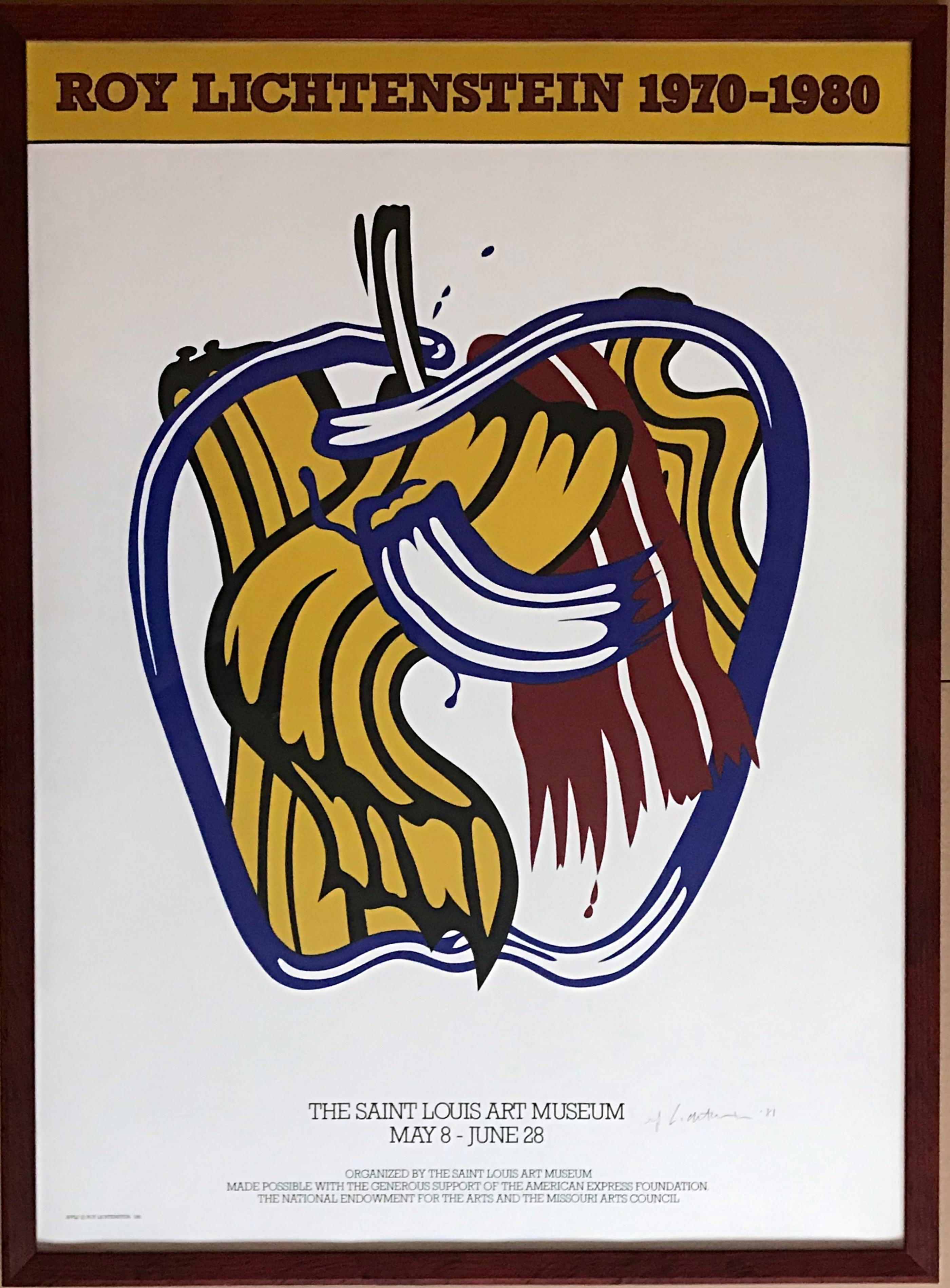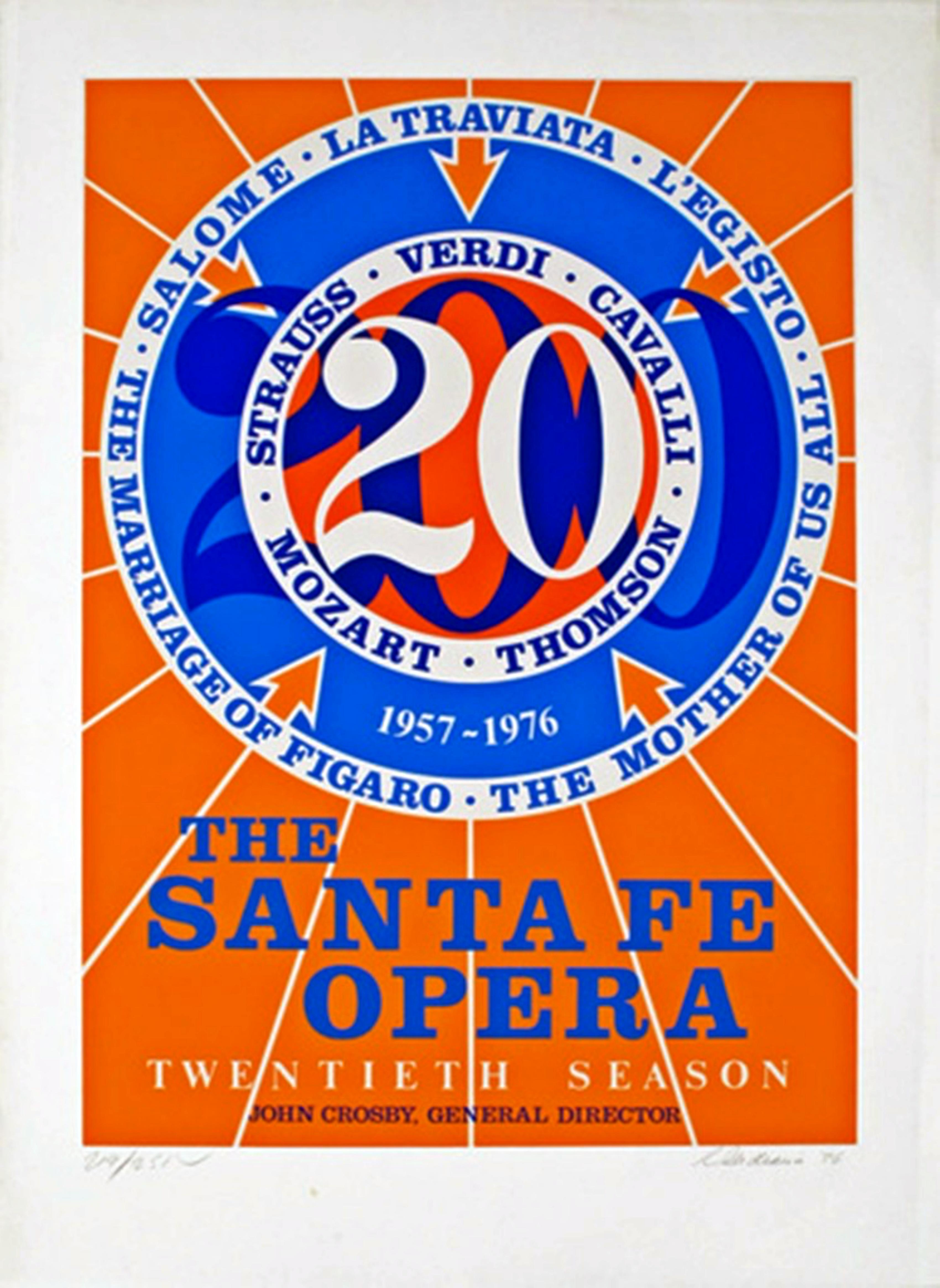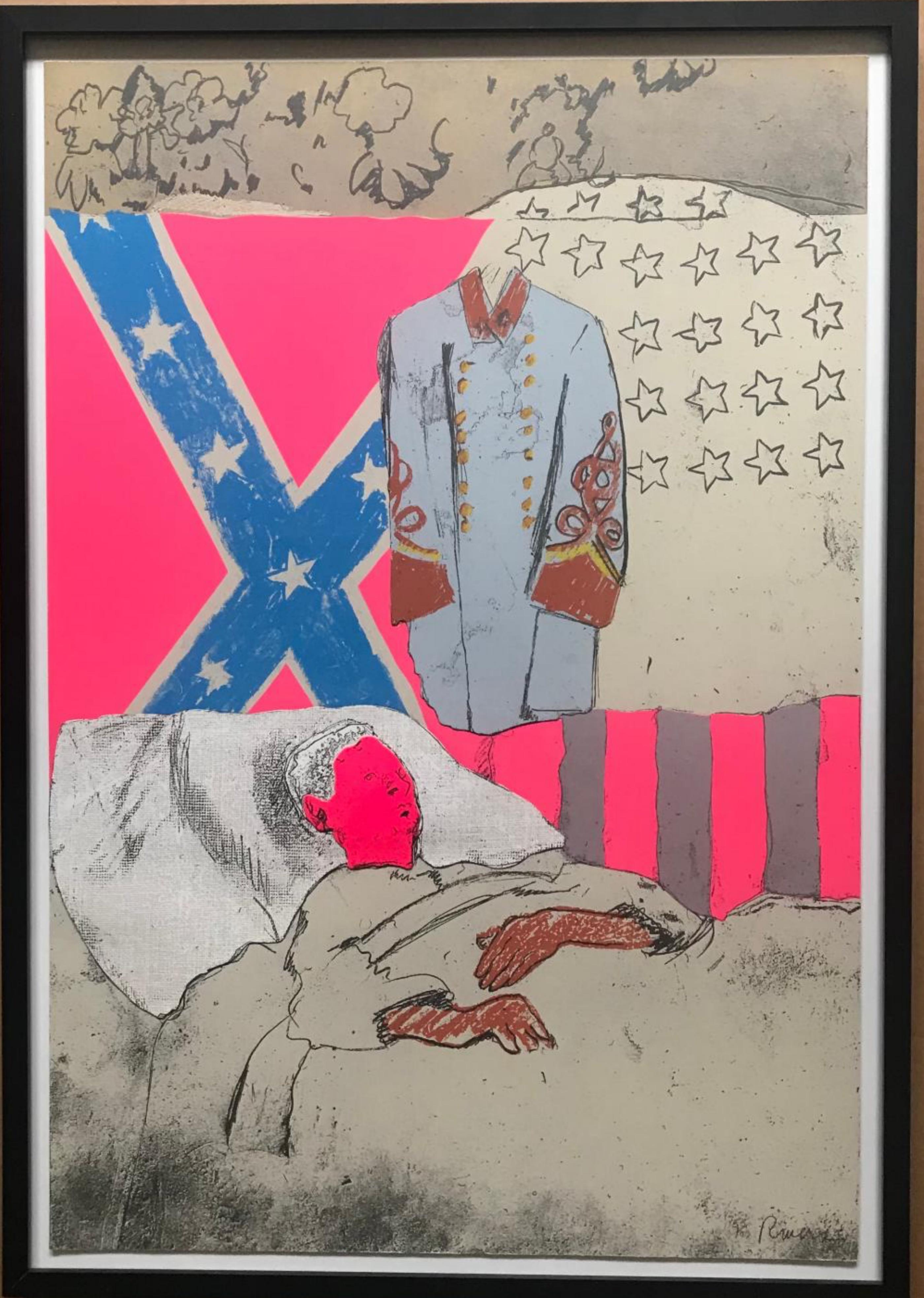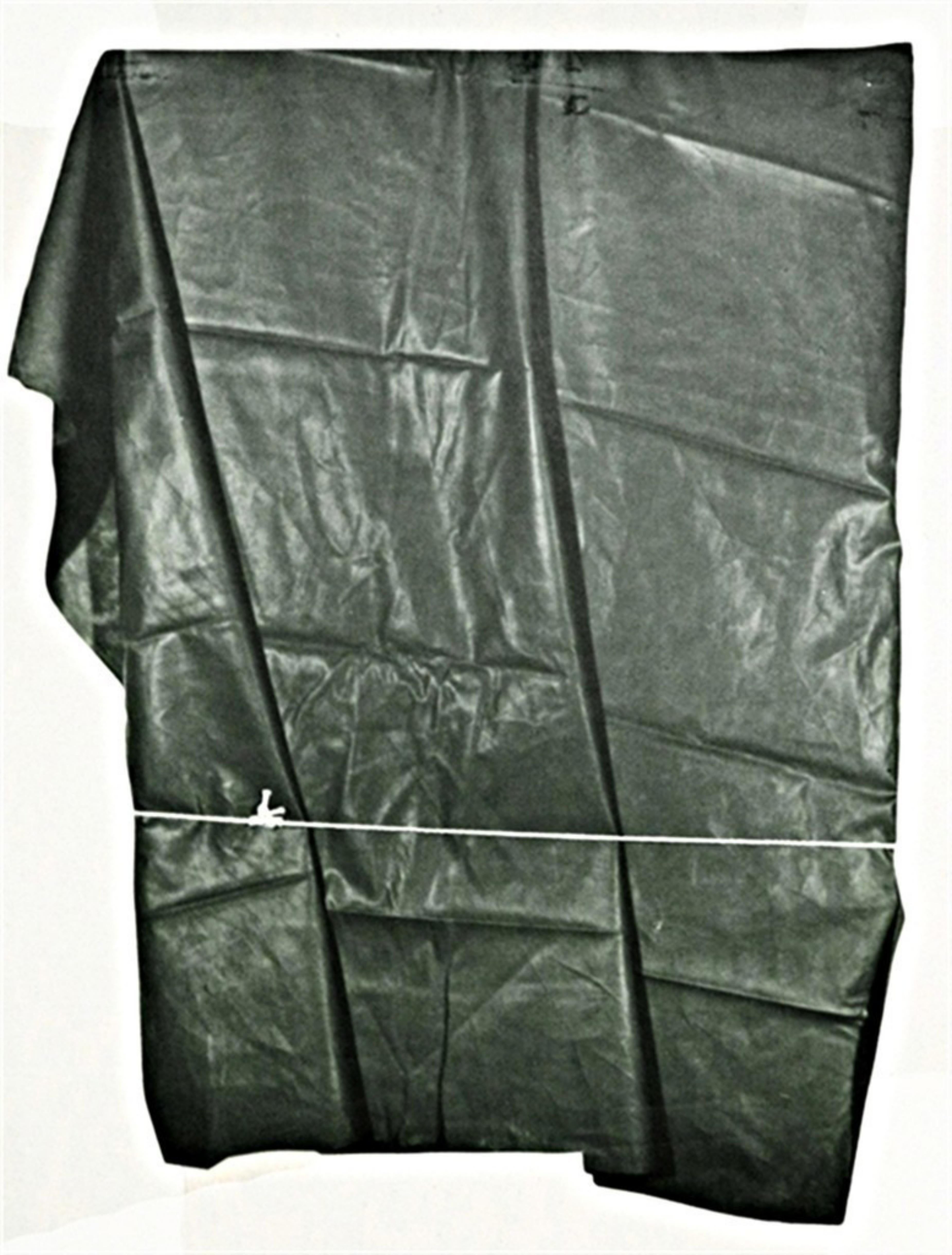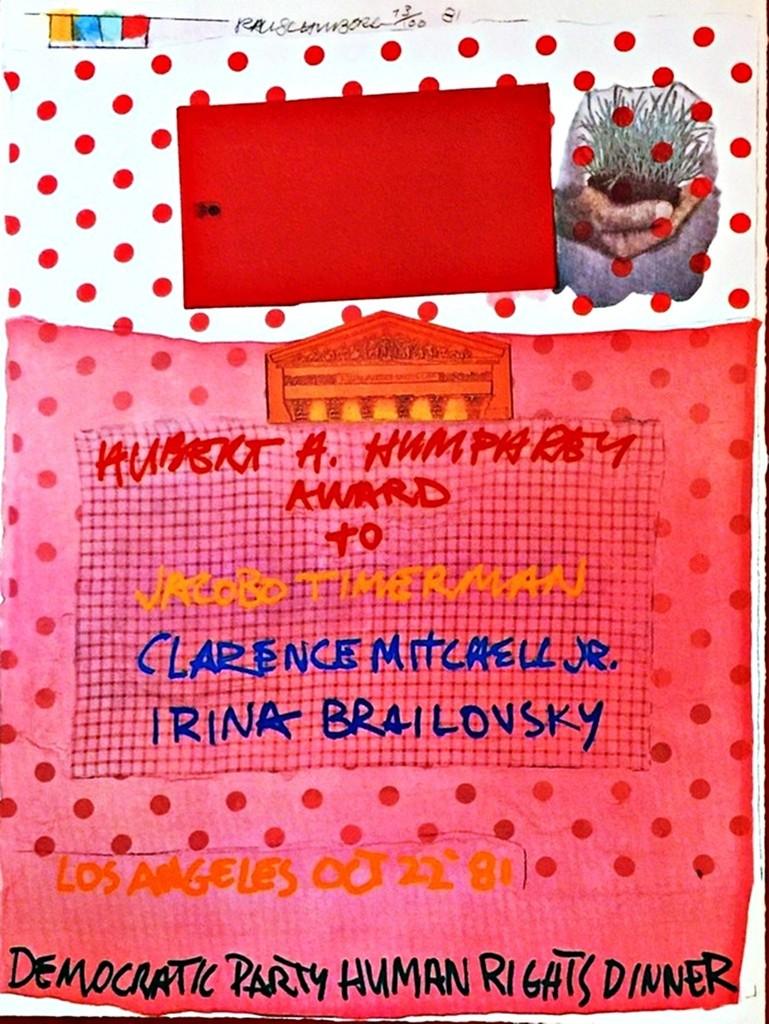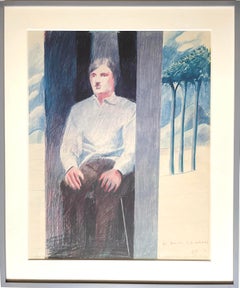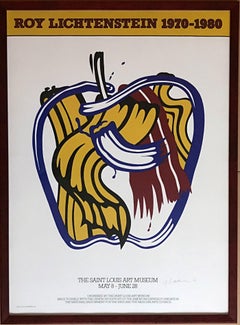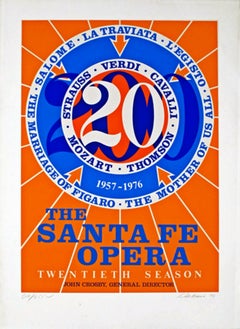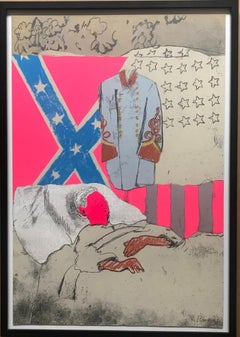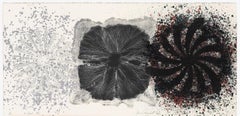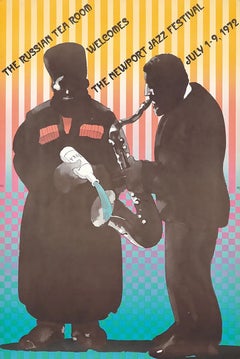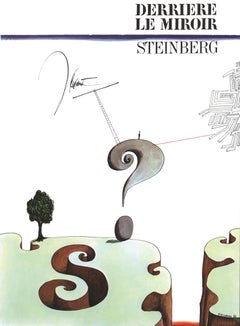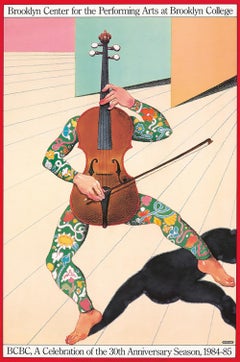Items Similar to Fun Vacation (200, Engberg) (Hand signed 13/16 by Ed Ruscha AND Kenny Scharf)
Want more images or videos?
Request additional images or videos from the seller
1 of 8
Ed Ruscha and Kenny ScharfFun Vacation (200, Engberg) (Hand signed 13/16 by Ed Ruscha AND Kenny Scharf)1990
1990
About the Item
Ed Ruscha and Kenny Scharf
Fun Vacation (200, Engberg), 1990
Lithograph in five colors on white Rives BFK paper (hand signed by BOTH Ed Ruscha and Kenny Scharf)
36 × 27 inches
Hand-signed by artist, Hand signed by both Ed Ruscha and Kenny Scharf lower right; dated lower right; hand numbered 13/16 in pencil; with the printer's blind stamp
Printed/Published by Hamilton Press
Catalogue Raisonné: 200, Engberg
Unframed
Rarely seen on the market, since most other editions are already in the permanent collection of major museums and institutions, "Fun Vacation (The Cruiser)" is the result of a unique collaboration three decades ago - 1990 - between Ed Ruscha and Kenny Scharf. This historic piece is hand signed by both Ruscha and Scharf and numbered from the very limited edition of only 16. A terrific piece for collectors and fans of both of these artists. The sheet has desirable deckled edges, excellent condition, with natural bleed-through colors, and therefore must ship flat and not rolled. The ship is a motif that Ed Ruscha has visited many times, particularly as it is pictured here as a shadowy mirage that seems to both emerge from and disappear into the fog. Ruscha’s work from this period is viewed by many as a metaphor for the end of the American Dream that was originated by valiant sailors as they sailed through uncertainty and found a new land. In a recent conversation at the Metropolitan Museum of Art, Ruscha acknowledged that his entire career has been preoccupied with this endlessly fascinating theme. And this work -depicting an almost unmoored ship, also alluding to American space exploration - is as emblematic as any of that theme. In this rare work, Ruscha and Scharf design a fantastical narrative around the recurrent motif of the ship. Here, the printed slogans and psychedelic color strips are emblematic of Ruscha and Scharf’s vibrant and satirist practice.
Ed Ruscha - Biography:
There are things that I’m constantly looking at that I feel should be elevated to greater status, almost to philosophical status or to a religious status. That’s why taking things out of context is a useful tool to an artist. It’s the concept of taking something that’s not subject matter and making it subject matter.
—Ed Ruscha
At the start of his artistic career, Ed Ruscha called himself an “abstract artist ... who deals with subject matter.” Abandoning academic connotations that came to be associated with Abstract Expressionism, he looked instead to tropes of advertising and brought words—as form, symbol, and material—to the forefront of painting. Working in diverse media with humor and wit, he oscillates between sign and substance, locating the sublime in landscapes both natural and artificial.
In 1956, Ruscha moved from Oklahoma City to Los Angeles, where he attended the Chouinard Art Institute. During his time in art school, he had been painting in the manner of Franz Kline and Willem de Kooning, and came across a reproduction of Jasper Johns’s Target with Four Faces (1955). Struck by Johns’s use of readymade images as supports for abstraction, Ruscha began to consider how he could employ graphics in order to expose painting’s dual identity as both object and illusion. For his first word painting, E.Ruscha (1959), he intentionally miscalculated the space it would take to write his first initial and surname on the canvas, inserting the last two letters, HA, above and indicating the “error” with an arrow. After graduation, Ruscha began to work for ad agencies, honing his skills in schematic design and considering questions of scale, abstraction, and viewpoint, which became integral to his painting and photography. He produced his first artist’s book, Twentysix Gasoline Stations—a series of deadpan photographs the artist took while driving on Route 66 from Los Angeles to Oklahoma City—in 1963. Ruscha since has gone on to create over a dozen artists’ books, including the 25-foot-long, accordion-folded Every Building on the Sunset Strip (1966) and his version of Kerouac's iconic On the Road (2009). Ruscha also paints trompe-l’oeil bound volumes and alters book spines and interiors with painted words: books in all forms pervade his investigations of language and the distribution of art and information.
Ruscha’s paintings of the 1960s explore the noise and the fluidity of language. With works such as OOF (1962–63)—which presents the exclamation in yellow block letters on a blue ground—it is nearly impossible to look at the painting without verbalizing the visual. Since his first exhibition with Gagosian in 1993, Ruscha has had twenty-one solo exhibitions with the gallery, including Custom-Built Intrigue: Drawings 1974–84 (2017), comprising a decade of reverse-stencil drawings of phrases rendered in pastel, dry pigment, and various edible substances, from spinach to carrot juice. The first retrospective of Ruscha’s drawings was held in 2004 at the Whitney Museum of American Art. Ruscha continues to influence contemporary artists worldwide, his formal experimentations and clever use of the American vernacular evolving in form and meaning as technology and internet platforms alter the essence of human communication. Ruscha represented the United States at the 51st Venice Biennale (2005) with Course of Empire, an installation of ten paintings. Inspired by nineteenth century American artist Thomas Cole’s famous painting cycle of the same name, the work alludes to the pitfalls surrounding modernist visions of progress. In 2018 Ruscha’s Course of Empire was presented concurrently with Cole’s at the National Gallery in London.
-Courtesy Gagosian
More about Kenny Scharf
Kenny Scharf is an American painter. He was born in 1958 in Los Angeles, California, where he currently lives and works. In 1978 he moved to New York to study at the BFA School of Visual Arts from which he graduated in 1980. He befriended artists such as Jean-Michel Basquiat, Andy Warhol, and Keith Haring, and gained notoriety in the 1980s in New York for bridging contemporary art and graffiti. Scharf uses images from popular culture, especially from TV cartoons such as The Jetsons, The Flintstones, and The Simpsons, to bring art to everyday life. His art highlights a kind of eternal youth, a utopic colorful pop world full of comical monsters, floating donuts, and one-eyed creatures.
-Courtesy Jeffrey Deitch
- Creator:Ed Ruscha and Kenny Scharf (1937, American)
- Creation Year:1990
- Dimensions:Height: 36 in (91.44 cm)Width: 27 in (68.58 cm)
- Medium:
- Movement & Style:
- Period:
- Condition:
- Gallery Location:New York, NY
- Reference Number:1stDibs: LU1745214012312
About the Seller
5.0
Platinum Seller
Premium sellers with a 4.7+ rating and 24-hour response times
Established in 2007
1stDibs seller since 2022
412 sales on 1stDibs
Typical response time: 2 hours
- ShippingRetrieving quote...Shipping from: New York, NY
- Return Policy
Authenticity Guarantee
In the unlikely event there’s an issue with an item’s authenticity, contact us within 1 year for a full refund. DetailsMoney-Back Guarantee
If your item is not as described, is damaged in transit, or does not arrive, contact us within 7 days for a full refund. Details24-Hour Cancellation
You have a 24-hour grace period in which to reconsider your purchase, with no questions asked.Vetted Professional Sellers
Our world-class sellers must adhere to strict standards for service and quality, maintaining the integrity of our listings.Price-Match Guarantee
If you find that a seller listed the same item for a lower price elsewhere, we’ll match it.Trusted Global Delivery
Our best-in-class carrier network provides specialized shipping options worldwide, including custom delivery.More From This Seller
View AllDavid Hockney, The Prisoner for Amnesty International, hand signed 17/100 Framed
By David Hockney
Located in New York, NY
David Hockney
The Prisoner, for Amnesty International, 1977
Color Offset Lithograph
Hand signed, numbered 17/100 and inscribed by the artist on the lower right front
Elegant hand made frame with UV plexiglass included
This color offset vintage lithograph by David Hockney is from the Deluxe hand signed and numbered edition of only 100, originally sold by Amnesty International to raise funds for their international human rights efforts. The present work is one of a series of art prints created by 15 artists to focus on Amnesty International's Prisoners of Conscience Year 1977. Other examples of these works were exhibited between February and March of 1977 in the Washington Place windows of New York University...
Category
1970s Pop Art Figurative Prints
Materials
Pencil, Graphite, Lithograph, Offset
Apple, Lt Ed St. Louis Art museum poster Hand Signed & dated by Roy Lichtenstein
By Roy Lichtenstein
Located in New York, NY
Roy Lichtenstein 1970-1980 (Hand Signed and dated by Roy Lichtenstein), 1981
Offset lithograph. Hand signed and dated in ink
Hand-signed by artist, H...
Category
1980s Pop Art Abstract Prints
Materials
Ink, Lithograph, Offset, Pencil, Graphite
Santa Fe Opera (Deluxe VIP Edition; Hand Signed & Numbered AP Edition of 50)
By Robert Indiana
Located in New York, NY
ROBERT INDIANA
Santa Fe Opera (Hand signed, numbered), 1976
Silkscreen on wove paper
37 1/2 × 27 inches
Edition AP 7/50
Hand Signed and dated lower rig...
Category
1970s Pop Art Abstract Prints
Materials
Screen, Pencil, Graphite
The Last Civil War Veteran limited edition signed mixed media silkscreen collage
By Larry Rivers
Located in New York, NY
Larry Rivers
The Last Civil War Veteran, 1970
Silkscreen and mixed media collage on paper
29 × 19 3/4 inches
Hand signed and numbered 55/100 in graphite pencil lower front
Provenance...
Category
1970s Pop Art Abstract Prints
Materials
Mixed Media, Laid Paper, Pencil, Graphite, Screen
MOCA Chicago Lithograph, first North American building Christo wrapped Signed/N
By Christo
Located in New York, NY
This is a truly historic limited edition hand signed museum print from the 1960s - of the first North American building the legendary artists Christo ever wrapped:
Christo
Wrap In Wr...
Category
1960s Pop Art Abstract Prints
Materials
Offset, Lithograph, Laid Paper, Pencil
Robert Rauschenberg Human Rights Dinner Signed Pop Art print edition of only 100
By Robert Rauschenberg
Located in New York, NY
Robert Rauschenberg
Human Rights Award, 1981
Silkscreen and Lithograph with Collage Embossing on Hodgkins Handmade Paper
Pencil signed and numbered 73/100 on the front
Silkscreen an...
Category
1980s Pop Art Abstract Prints
Materials
Pencil, Lithograph, Screen
You May Also Like
Large American Pop Art Color Abstract Lithograph "Black Tie" James Rosenquist
By James Rosenquist
Located in Surfside, FL
Black Tie, 1977
James Rosenquist, American, 1933–2017.
Printed by Maurice Sanchez at Derrière L'Étoile Studios, Inc.
Published by Sidney Singer
Color lithograph on rolled white Arches Cover paper
Blindstamp of a man in a hat, bottom right
Hand signed in pencil. Dated 1977 lower right. Titled and numbered 76/100 lower left.
Measures 73 1/2" x 37
James Rosenquist (November 29, 1933 – March 31, 2017) was an American artist and one of the proponents of the pop art movement. Drawing from his background working in sign painting, Rosenquist's pieces often explored the role of advertising and consumer culture in art and society, utilizing techniques he learned making commercial art to depict popular cultural icons and mundane everyday objects. While his works have often been compared to those from other key figures of the pop art movement, such as Andy Warhol, JIm Dine and Roy Lichtenstein, Rosenquist's pieces were unique in the way that they often employed elements of surrealism using fragments of advertisements and cultural imagery to emphasize the overwhelming nature of ads. He was a 2001 inductee into the Florida Artists Hall of Fame.
Rosenquist was born on November 29, 1933, in Grand Forks, North Dakota, the only child of Louis and Ruth Rosenquist. His parents were amateur pilots of Swedish descent who moved from town to town to look for work, finally settling in Minneapolis, Minnesota. His mother, who was also a painter, encouraged her son to have an artistic interest. In junior high school, Rosenquist won a short-term scholarship to study at the Minneapolis School of Art and subsequently studied painting at the University of Minnesota from 1952 to 1954. In 1955, at the age of 21, he moved to New York City on scholarship to study at the Art Students League, studying under painters such as Edwin Dickinson and George Grosz. Talking about his experience at the Art Students League, Rosenquist said "I studied only with the abstract artists. They had commercial artists there teaching commercial work, I didn't bother with that. I was only interested in -- see, here's how it started. I was interested in learning how to paint the Sistine Chapel. It sounds ambitious, but I wanted to go to mural school". While studying in New York, Rosenquist took up a job as a chauffeur, before deciding to join the International...
Category
1970s Pop Art Abstract Prints
Materials
Lithograph, Color
Milton Glaser The Newport Jazz Festival
By Milton Glaser
Located in NEW YORK, NY
Milton Glaser Newport Jazz Festival at The Russian Tea Room:
The Russian Tea Room is an iconic restaurant in NYC located next to New York's Carne...
Category
1960s Pop Art Figurative Prints
Materials
Lithograph, Offset
$396 Sale Price
20% Off
Saul Steinberg lithographic cover c.1970 (derriere le miroir)
By Saul Steinberg
Located in NEW YORK, NY
Saul Steinberg Derrière le Miroir:
A lithographic cover published c. 1970. Well suited for framing. A fantastic vintage Saul Steinberg collectible within reach.
Lithograph in color...
Category
1970s Pop Art Abstract Prints
Materials
Lithograph
Milton Glaser Brooklyn Center for the Performing Arts (Milton Glaser posters)
By Milton Glaser
Located in NEW YORK, NY
1980s Milton Glaser Poster Art:
Milton Glaser Brooklyn Center for the Performing Arts at Brooklyn College: Vintage original Milton Glaser poster c.1984. Designed by Milton Glaser on the occasion of the 30th anniversary of the Brooklyn Center for the Performing Arts at Brooklyn College. In this piece Glaser creates music and dance incarnate: A colorful figure appears headless, its torso formed...
Category
1980s Pop Art Figurative Prints
Materials
Lithograph, Offset
Milton Glaser Sony Tape, Full Color Sound poster 1980 (Milton Glaser posters)
By Milton Glaser
Located in NEW YORK, NY
Milton Glaser Sony Tape, Full Color Sound poster 1980:
Vintage original 1980s Milton Glaser poster designed by Glaser for the world-recognized brand Sony. A classic Milton Glaser advertising design featuring the profile of a 19th-century music listener silhouetted against music liner paper.
Offset lithographic poster in colors.
30 x 45 inches.
Very good overall vintage condition with the exception of perhaps some minor signs of handling.
Vintage original print.
Milton Glaser printed signature upper left; from an edition of unknown.
Literature:
Milton Glaser Posters, Glaser, pg. 251.
Legendary graphic designer, illustrator, and art director Milton Glaser created some of the most recognizable iconography in America today —including the iconic I ♥ N Y logo —and countless posters and ad campaigns. Glaser changed the face of commercial art in the 1960s and ’70s, breaking with the conventions of modernism and drawing inspiration from a wide variety of art-historical and pop-cultural sources, from Art Nouveau to comic illustration...
Category
1960s Pop Art Figurative Prints
Materials
Lithograph, Offset
Large Bus by Allen Jones classic British 1960s pop art in bright primary colors
By Allen Jones
Located in New York, NY
This large Allen Jones lithograph is printed exuberantly in primary colors. A swath of bright red brushstrokes represents the side of a bus. In the upper left, small windows reveal the passengers: a woman’s face is cut off above her vampy red lips, and a blue-haired man’s face is hidden. Royal blue fills the upper right corner of the composition, giving the impression of looking up at a passing bus against the cloudless sky. One can imagine Jones was thinking of the iconic red double decker bus the AEC Routemaster, first introduced in London in 1954. In the 1960s buses were a living symbol of familiar and new technology coexisting: as David Bucken put it, “In and around London a midpoint change on a journey might involve alighting from an RT bus, of which production had started just prior to World War II, and getting on one of the sexy new Routemasters.”
In the artist’s words: “The whole problem as a figurative artist was that it was going against the main march of modernism, which was towards abstraction. But here was a way of making the subject you were painting the same as the object you were painting on. By making the canvas a rhomboid, and putting little wheels on it, you have a schematic version of a vehicle, in this case a
London bus.” Jones plays with the space between abstraction and figuration: windowed passengers, elaborated with just a few lines and placed adjacent to a weighty red ground of brushstrokes, easily convey the form of a bus, yet the print also conveys Jones’ visceral, painterly delight in color play.
Four color lithograph on wove paper
Paper 28.5 x 42.5 / 72.4 X 108 cm
Wood frame 31 x 46 x 2 in. / 78.75 x 117 x 5 cm with 1 in. moulding
Signed by the artist lower right in pencil, labeled Trial Proof lower left in pencil. Edition 20. Printed at Tamarind Los Angeles with Clifford Smith...
Category
1960s Pop Art Abstract Prints
Materials
Lithograph
Recently Viewed
View AllMore Ways To Browse
Vintage And Rare London
Hand Bound Book
Empire Black Motif
Vintage Arrow Sign
Folding Blind
Folding Fan Vintage
Vintage Folding Hand Fan
Walkman Sony
Walter Henry Sweet Painting
Willem Botha
William Callow
Wizard Of Clay
Wizard Of Oz Plates
World War I Poster Black Tom
Wwii Chinese Poster
Y Gianni
Yoshitoshi Moon
Yuki Gray

